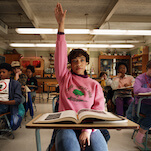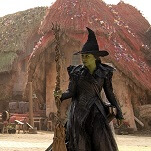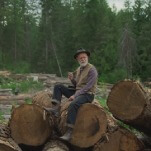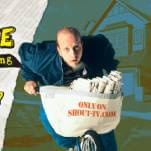The team-up between Image marketing genius Todd McFarlane (Spawn) and new Image partner Robert Kirkman (Invincible, The Walking Dead) is exactly what it should be: In a blind taste test, comics fans should be able to read the new series Haunt (Image) and identify its creators based solely on signature styles. It’s solidly commercial, with a quick payoff of sex and violence, and the promise of supernatural superhero mayhem to come; in effect, it reads exactly like Invincible with a harder-edged horror tinge replacing the four-color glossy tone. The “very first debut issue,” as Kirkman puts it in a cheerful afterword, doesn’t have much time for nuance as it sets up a story taken straight from the heyday of EC Comics. There’s a priest, Daniel, with a brother, Kurt, involved in a shady-looking black-ops mission that involves killing his way through the jungle to liberate a mad-scientist type performing horrific experiments on human subjects. Kurt winds up dead, but is still apparently hanging around and advising/bugging the reluctant Daniel, but when Kurt’s unresolved shit hits Daniel’s fan, they seemingly merge into a clawed, costumed creature that looks more than a bit like zombie black-costume Spider-Man. The writing is familiar Kirkman stuff: clipped, clean, and efficient in setting up archetypes and moving the story along. McFarlane’s inks (over Ryan Ottley's pencils) are recognizably his art, especially when portraying busty women, strong-chinned men, and the angsty-looking supernatural hero. (Not to mention when things get bloody.) As with so many first issues, it’s hard to tell what this will become over time; it’s hard to say whether the story will be worthwhile over the long run. But fanboys excited over the dream-time hookup are buying the first issue like hotcakes, so it’s a pretty sure bet that the series will last long enough for us to find out… B
Most comics adaptations of the Bible aim to streamline or re-interpret what can be a dense, tricky text, but R. Crumb’s The Book Of Genesis (Norton) tries to be as faithful as possible, and in the process reveals just how archaic and inscrutable the Bible can be. Relying heavily on a Robert Alter translation (alongside the King James version), Crumb illustrates Genesis chapter by chapter, leaving in many of the long lists of family lines, as well as the stories designed to impart now-obscure lessons to ancient religious communities. In an appendix at the end of the book, Crumb speculates some about what Genesis may have been saying about the fluidity of patriarchies and matriarchies in days of yore, but mainly he lets the words speak for themselves, even when the stories repeat, contradict themselves, or seem to have no point. While the text of The Book Of Genesis can be a slog, Crumb’s art is typically magnificent, and adds its own layer of meaning. Eschewing awe, and striving for historical accuracy whenever possible, Crumb draws a Bible full of ordinary-looking people consumed by toil, family squabbles, and sexual desire, in between the casual conversations they have with an ever-present, oddly capricious God. Rarely has a holy book seemed so plain—and frankly, so irrelevant… B+
Max Brooks has made a living out of the dead. His Zombie Survival Guide combined a wry commitment to its premise with a striking ability to imagine the worst, and the follow-up, World War Z: An Oral History Of The Zombie War, forewent the Guide’s semi-parody for a straight-faced, horrific Studs Terkel style. The Zombie Survival Guide: Recorded Attacks (Three Rivers Press) ties into Brooks’ first book with illustrated accounts of some of the earliest zombie infestations known to man, starting in 60,000 B.C. and ending in modern times. Each chapter is short, punchy, and dialog-free, like a series of jokes where the point is shivers instead of laughter. The collection is hit-and-miss, and Brooks’ writing references history without feeling especially connected to it. But he’s clearly enjoying himself, and Ibraim Roberson’s black-and-white art is detailed, moody, and appropriately gory. The lack of a single narrative, and the brevity of each section, makes for a shallow experience, but if digging the sight of the Foreign Legion holding firm against waves of the dead is wrong, who wants to be right? B+
Berkeley Breathed’s Bloom County debuted in late 1980, during what proved to be the last great wave of newspaper comic strips. A number of popular young cartoonists emerged in the ’70s and ’80s, culminating in the arrival of instant legends Breathed, Gary Larson, and Bill Watterson. Oddly, all three men retired their strips after relatively short runs, though the popularity of Larson’s The Far Side and Watterson’s Calvin & Hobbes has endured well beyond their creators’ retirements. Not so much Bloom County. When Breathed put his strip to rest in 1989, he followed it up with bestselling children’s books (and two more strips that never really caught on, Outland and Opus), but while plenty of people fondly remember reading Bloom County in the ’80s, the strip hasn’t really been passed down to successive generations the way Peanuts and Calvin & Hobbes have. Reading the nicely packaged hardcover collection The Bloom County Library, Volume One: 1980-1982 (IDW/The Library Of American Comics), it’s easy to see why. Profoundly influenced by Garry Trudeau, Breathed made Bloom County arguably the most topical strip on the comics page, commenting on the Reagan-era follies of fat-cats and moral majorities. But Breathed didn’t really go for subtle Doonesbury-style satire; he liked shouting and slapstick and punchlines where the name of a politician or celebrity was a joke in itself. Put plainly, Bloom County looks pretty dated now, and is rarely as funny or subversive as it once seemed. That said, the two years of strips in the first volume of The Bloom County Library retain a lot of charm, in large part because in the early going, Breathed was still trying to find the right cast and the right point of view for the strip, which led to him adding characters on a near-weekly basis until he found the right mix of yuppies, freaks, idealists, and talking animals. The early Bloom County is a wild ride, and not just because it features far more smoking, drinking, and sexual innuendo than the comics page would allow today. There’s a vibrancy and confidence to what Breathed was up to, such that even when he was blatantly ripping off Trudeau, Charles Schulz, and Walt Kelly, he did so with gusto enough to make other artists’ tricks look fresh and personal. The jokes in Bloom County have gathered dust, but the art and the attitude still pop… A-
Years in the making, and first appearing in sporadic bursts as an online comic, Kevin Cannon’s Far Arden (Top Shelf) is finally fully collected in a handsome hardbound brick of a book, and it’s well worth the wait. The story of Army Shanks, a hard-boiled seafaring adventurer engaged in a quest for a perhaps-mythical Arctic paradise known as Far Arden, the book skillfully combines dramatic soap-opera threads with a clever mystery and tons of rip-roaring adventure in a high style that isn’t seen much in comics anymore. The storytelling is solid, and on the rare occasions it lags, Far Arden is carried along by Cannon’s energetic, boisterous art and his setting, a compelling alternative version of the Canadian Arctic. It all leads to an ending that’s surprisingly poignant and sad. One of the best graphic novels of the year… A
The Best American Comics 2009 (Houghton Mifflin) splits the difference between the superb 2006 and 2008 editions and the disappointing 2007 version. Guest editor Charles Burns picks a lot of pieces from contemporaries like Gary Panter, Dan Clowes, Peter Bagge, and Jerry Moriarty, and favors autobiography and narrative sketches—which is all to the good. But Burns is also way too enamored of the more primitivist art-comics types, which makes too much of The Best American Comics 2009 look like page after page of crude scribbles—surely off-putting to the casual bookstore browser. Still, Burns and series editors Jessica Abel and Matt Madden have unearthed some excellent, little-seen material by some major artists (like Chris Ware and Ben Katchor, who are represented by pieces that ran outside their usual venues). And though the series’ insistence on excerpting pages from longer stories remains frustrating, this time out it may have been necessary in order to cover a few of the genuine best comics of the year, like Mimi Pond’s Over Easy, a funny, well-observed autobiographical sketch about waitressing through art school, and “Pulverize,” a portion of Kevin Huizenga’s latest Ganges issue that may be the best sustained stretch of storytelling in the young cartoonist’s career to date. These are the kind of stories likely to get novice readers interested in the potential of comics—and maybe remind long-time fans why they love the medium so… B
Now that the social and aesthetic impact of comics is fully realized even among skeptical academics, a full culture-studies treatment of the early days of Marvel Comics should find an eager audience. Unfortunately, Pierre Comtois’ Marvel Comics In The 1960s (TwoMorrows) isn’t that book. An issue-by-issue analysis of Marvel’s steady, sometimes shocking transformation from a second-rate publisher to a pop-cultural game-changer, Comtois’ book hints at the greater cultural milieu in which Stan Lee, Steve Ditko, Jack Kirby and their colleagues operated, but doesn’t go into much depth. Instead, it goes for reverence instead of insight, and it focuses on often-familiar details that fans have already seen before and non-fans are unlikely to care about. A decent effort, but it isn’t the book this topic needs right now… C+
Calling Osamu Tezuka prolific and influential to the world of Japanese comics and cartoons means seriously devaluing both those words. There are almost as many books about Tezuka as there are books by Tezuka, but The Art Of Osamu Tezuka: God Of Manga (Ilex/Abrams) is special for a number of reasons: It’s the first authorized biography of the man, it contains dozens of fantastic illustrations never before seen outside his own country, and Helen McCarthy, its author, has written a handful of excellent books about the medium and curated an exhibit of his work at the Barbican Centre. That immersion in manga serves her well, as the biography not only provides excellent examples of Tezuka’s work and delivers a respectful but never fawning narrative of his life, but also places him in an informative context about the growth of Japanese comics and animation. It’s also a bargain at $40, with tons of glossy illustrations, a beautifully designed hardcover package, and a DVD documentary included… A-
Translated into English for the first time since it was written, more than 25 years ago, Jacques Tardi & Jean-Claude Forest’s You Are There (Fantagraphics) proves well worth the wait. Forest’s satirical, minimalist writing lampoons French society and human greed with equal skill, and Tardi has never done better art: It’s all deep, dark pools of blackness that perfectly match the pitch-dark humor of the writing. Equal parts Beckett and Kafka, the story explores the conflict between greedy speculators and the last heir of an aristocratic family whose land has been reduced to a series of precarious walls and towers. Tardi’s intricate, gorgeous art gets better and better until the book’s spectacular ending. It’s an absolute must-read for anyone interested in how European comics got to where they are today. Had this been translated earlier, it likely would be counted as one of the masterpieces of the rich period of the mid-’80s… A
Collecting a number of the better entries in a series reboot that started three years ago, Savage Tales Of Red Sonja (Dynamite Entertainment) isn’t perfect, but at least it’s an attempt to treat the longtime supporting character from the Conan universe as something more than stroke material for adolescent boys. That element certainly is present here—Sonja isn’t wearing a hijab anywhere in the trade-paperback collection—but spicy thrills aren’t the primary factor at work in what turns out to be a decent, solid collection of sword-and-sorcery stories. The book suffers from inconsistency in both art and story; Michael Avon Oeming, Ron Marz, and Joyce Chin all turn in good work in the latter category, but few artists can keep up with the iconic cover by Arthur Suydam. But for Conan fans, this is a good addition to the comics canon, and a step forward for the character… B
Eddie Campbell’s “Alec” stories were among the first of the modern era of autobiographical comics, and they still rate among the best—witty, brilliantly illustrated, self-mocking without ever being mopey or pathetic, and most importantly, forever changing style to suit the needs of the story. After many years of sporadic availability, they’re finally all available in one volume. Alec: The Years Have Pants (Top Shelf) collects every Alec tale from the confident, funny The King Canute Crowd to the present, with lots of bonus material and previously uncollected works (including the excellent History Of Humour) thrown in. Watching Campbell’s storytelling and approach to art progress and evolve as these stories unfold is as close as you can get to watching a real human life change on the page. One of the must-own releases of the year… A
Michael Dougherty’s horror film Trick ’R Treat has followed a rocky path to cult success. Originally intended for an October ’07 release, it kept getting pushed back by Warner Brothers, before being dumped onto DVD earlier this month. (It’s already generating good word of mouth; look for the review here next Wednesday.) And now the four-part comic-book series that Wildstorm intended to release in ’07 has been unceremoniously bundled into a trade paperback, with little supplementary material to help people who aren’t already Trick ’R Treat fans understand what they’re reading. Frankly, the collected Trick ’R Treat (Wildstorm), while well-drawn and full of gleefully gory images, is awfully hard to follow on its own. Sticking with the basic plot of the movie, the book follows the events of one Halloween night in one neighborhood, where deadly secrets lurk behind seemingly every door. Marc Andreyko adapts Dougherty’s script, with art by Mike Huddleston, Grant Bond, Christopher Gugliotti, and Fiona Staples. When the stories stay simple (along the lines of “murderous principal deals with corpse of student” or “hermit stalked by pumpkin-faced killer”), they come across well, but when the stories rely on a lot of setup (like “fairy tale gets turned on its head” or “victims of a horrible crime seek revenge”), they’re less successful. And the book as a whole does a lousy job of getting across how all these stories are interconnected, primarily because the different artists draw the characters in different ways. As a souvenir of the movie, Trick ’R Treat is perfectly fine, but as a standalone reading experience, it’s only intermittently exciting, and ultimately unsatisfying… C+
The Seth-designed “John Stanley Library” series continues with Nancy (Drawn & Quarterly), which collects five Stanley-penned issues of Dell’s comic-book version of Ernie Bushmiller’s classic newspaper strip. The stories here are very good—classic kid-comic adventures that usually start with Nancy trying to accomplish something simple that eventually spins out into accidental mischief and outright absurdity—and the book itself looks fantastic. But as with the Melvin Monster volume of the JSL, the effort to frame the Nancy volume as an artifact out of time gives the shaft to those interested in the story behind the stories. Why these five issues? Why only five issues? Why not reprint the covers? How do these comics fit in with the rest of the Dell line, or with the rest of Stanley’s work? It may seem ungrateful to gripe about such a delightfully packaged collection of hard-to-find comics, but the lack of contextual material in these John Stanley Library volumes is starting to become more outright annoyance than eccentric affectation… B+
The Art Spiegelman and Françoise Mouly-curated anthology The Toon Treasury Of Classic Children’s Comics (Abrams Comicarts) will give history-minded comics fans more of what they’re looking for—and it contains several John Stanley stories to boot. The book offers more than 350 oversized, hardbound pages of funny-animal comics, kid-friendly gag cartoons, and the adventures of licensed characters like Donald Duck, Dennis The Menace, and Little Lulu. The Toon Treasury has been divided into sections like “Fantasyland” and “Weird & Wacky,” each of which features an introduction, and between those intros, the annotated table of contents, and the creator bios in the back, this book offers ample evidence of the artists and styles that dominated kid-comics in their ’40s and ’50s heyday. It’s also the kind of book that actual children can sprawl out on the floor and read, enjoying the gorgeous art and wild imagination of masters like Carl Barks, Walt Kelly, Sheldon Meyer, and Harvey Kurtzman. It’s never too early to develop an appreciation for true quality… A
The ill-conceived DC Comics Classics Library series—which so far has been dedicated to reprinting stories of middling historical and/or aesthetic value, at a needlessly high price—continues to get it wrong with Justice League Of America By George Pérez: Volume One (DC). Pérez’s work on the early-’80s JLA is worth collecting: Though these comics aren’t as memorable as Pérez’s collaborations with Marv Wolfman on the contemporaneous New Teen Titans, Pérez’s art is dynamic, and Gerry Conway’s stories are generally entertaining. (Though they all end sort of abruptly, as though Pérez ran out of paper before he ran out of script.) And the CCL package is well-assembled; it includes an introduction, an afterword, and bonus art, and the printing job is pristine. But the price point remains ridiculous for this series. DC is asking for $40 for a normal-sized hardcover containing reprints of only six issues. Pérez only penciled four more issues of Justice League during this run. How hard would it have been to include those issues, instead of shuffling them off to Volume Two, which is also $40? For that matter, why does the price need to be so high to begin with? By contrast, the new collection Final Crisis: Legion Of 3 Worlds (DC) is of a comparable size and arguably of superior quality in terms of its art and story, and yet it only lists for $20. Writer Geoff Johns spins off from DC’s Final Crisis crossover to tell a story of three Legions Of Super-Heroes from three different universes, banding together under Superman’s leadership to fight the evil Superboy-Prime and The Legion Of Super-Villains. The story offers fairly typical “Here’s a bunch of old characters fighting” fare, but with Pérez handling the art chores (with inks by Scott Koblish), both the characters and the fighting look absolutely awesome. This is a collection for people who like a lightning pace and page after page of costumed mayhem. And it’s a relative bargain… JLA: C-; Legion: B+
And getting back to McFarlane… Running only second to Ghost Rider in the “Characters Inspired By Bad Van Art” lineup, Spawn has always been more about cool-looking ideas than actual grounded writing or storytelling. Given that McFarlane created the character, that isn’t surprising; he’s always had a knack for great images, but not much interest in depth, which can threaten market share and alienate an audience whose biggest interest in his work is saying, “Ooooo, freakin’ sweet!” over and over again. Spawn: Book Of The Dead (Image) attempts to summarize nearly two decades’ worth of overheated storytelling in 104 pages of melodramatic prose by Steve Niles and David Hine, and murky, CD-booklet artwork by Ashley Wood. While there’s no doubting the book’s efficiency, its purpose leaves something to be desired. Without the catastrophic images of McFarlane’s original design (and the artists he inspired), Book is like the opening crawl of a Star Wars prequel: heavy on exposition, light on fun. C-







































